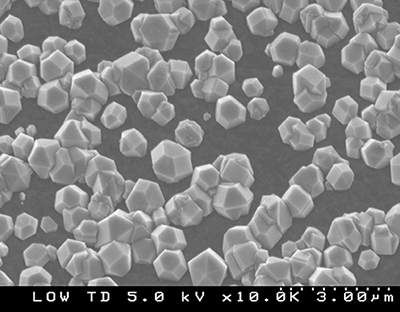Multiplying Electrons With Diamond
As researchers in the Space Communications Division of NASA's Glenn Research Center in 1992, Dr. Gerald Mearini, Dr. Isay Krainsky, and Dr. James Dayton made a secondary electron emission discovery that became the foundation for Mearini's company, GENVAC AeroSpace Corporation. Even after Mearini departed Glenn, then known as Lewis Research Center, his contact with NASA remained strong as he was awarded Small Business Innovation Research (SBIR) contracts to further develop his work.
Mearini's work for NASA began with the investigation of diamond as a material for the suppression of secondary electron emissions. The results of his research were the opposite of what was expected—diamond proved to be an excellent emitter rather than absorber. Mearini, Krainsky, and Dayton discovered that laboratory-grown diamond films can produce up to 45 electrons from a single incident electron. Having built an electron multiplier prototype at NASA, Mearini decided to start his own company to develop diamond structures usable in electron beam devices.
Mearini proposed and received Phase I SBIR funding from Glenn to continue his work to prove diamond's potential as a device material. Since then, his Cleveland, Ohio-based company has improved secondary electron emissions from laboratory-grown diamond to produce greater than 60 electrons from a single impinging electron. Diamond produces 15 times more electrons than other materials used to amplify electrons, giving diamond the highest known secondary electron emission coefficient.
Companies making electron beam devices use GENVAC's diamond product. GENVAC produces chemical vapor deposited diamond as a dynode for electronic and electro-optical device components. Diamond dynodes allow manufacturers to make devices considerably smaller, in addition to increasing their efficiency and reliability. Applications include electron beam amplification devices such as night vision goggles and specialized sensors, field emission cathodes for flat panel displays, and heat spreaders for thermal management.
In another field, a leading manufacturer and supplier of specialized electron tubes and electro-optic products applied GENVAC's diamond to its dynodes for photo multiplier tubes (PMT) with medical applications. Beginning with the production of diamond-based PMTs in late 2000, the technology is leading the way for smaller, more efficient medical devices.
Dayton, who was Glenn's Electron Beam Technology Branch Chief, retired from NASA in 1998 to become Director of Technology at Hughes (now Boeing) Electron Dynamic Devices, in Torrance, California. After 3 years of commuting between Los Angeles and Cleveland, he resigned from Boeing and joined GENVAC as Director of Technology in November 2001.
GENVAC continues to work with NASA through the SBIR program. The company was recently awarded a Phase I SBIR contract from NASA's Jet Propulsion Laboratory to develop a diamond-based sub millimeter backward wave oscillator. The company has also been selected by Glenn to develop a diamond-based 60-Gigahertz miniature Traveling Wave Tube.

This image shows a diamond field emitter. Laboratory-grown diamond films can produce up to 45 electrons from a single incident electron, making them an excellent emitter.













